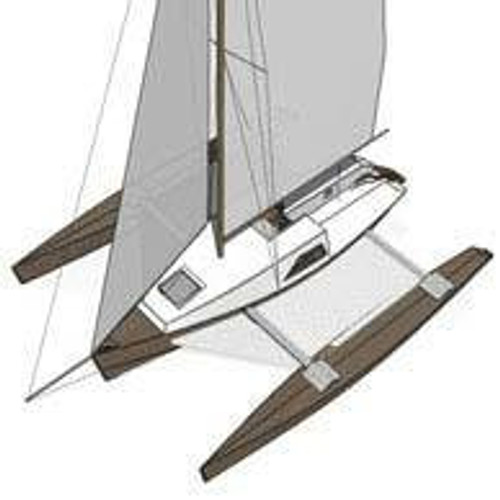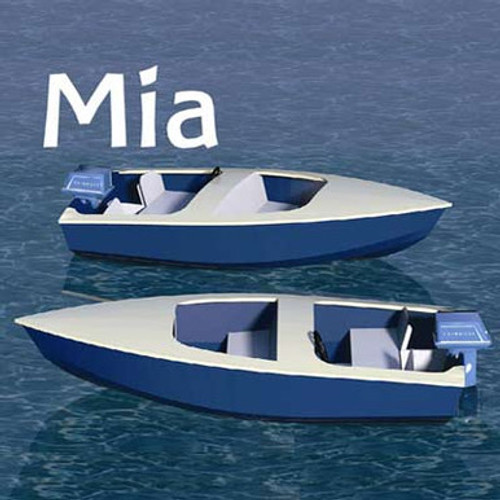These are full plans. For Study Plans, click HERE
For those who design boats for amateur boat builders, the small cruise trimaran represents a complex and stimulating theme. The challenge is to simplify its design and facilitate the construction of a boat which, in itself, is rather complex. It is obvious that, compared to the study of a mono-hull, that of a trimaran is more laborious, due to the fact that there are two more hulls and the beams. Things become even more complicated if these have to be quickly dismounted to facilitate transport and be retractable in order to reduce overall dimensions at mooring.
Besides that, nearly all the problems encountered in nautical design work are - for this type of boat - aggravated and of difficult solution. Take, for example, the need to combine high performance with navigation comfort (with less available space compared to a mono-hull boat), lightness and structural solidity, or safety issues connected with heeling or even capsizing; that would be enough to discourage the designer from getting involved with this type of boat in the first place.
If, despite this fact, we have decided to tackle the ordeal, it is for two motives: the first is that during navigation, few other boats are able to give the same emotions and satisfaction as the trimaran does. No other cruising monohull, with similar characteristics and dimensions, is able to compete at the same speed, with a multi-hull.
Compared to a catamaran, the trimaran is more agile, enjoyable to sail, evolutionary and fast with light winds. We, therefore, consider it the ideal boat for fast, enjoyable cruising. Internal space is not much (less than what we might find on a mono-hull or on a catamaran) but, it is compensated by the possibility to utilize open spaces, both in the cockpit as well as on the sheets of netting.
As far as safety is concerned, multi hulls have pros and cons if compared with mono hull boats. Without going too deeply into the question, we will simply say that for a non-extreme trimaran, such as the TRILLO, safety margins are high and to be able to capsize it, one has to commit very serious or heedless mistakes. However, in critical conditions, the helmsman will have to understand when it is the right moment to reduce sail , but this is valid for any type of boat.
If boats with such positive characteristics are not so widespread, neither among users nor among self-builders, it is because of the complex design which we spoke about, that often lead to high costs and difficulty in construction. With the TRILLO, we believe (and this is the second reason which has pushed us into designing it), it is possible to offer something simpler, more economical and easy to build, compared to what the market has to offer.
There are, on the market, excellent trimarans of this size or dimension and, we do not believe that - compared to those - ours is better from an aesthetic point of view, that it offers better performance or, that it is more functional or innovative. What we have, actually, concentrated on is to achieve the simplest and most practical solutions for the constructor. For example, with regard to the crossbeams, we believe that our solution (with telescopic) looks less elegant compared to others based on sophisticated systems. It is, however, the simplest and most functional for an amateur. The same applies for the type of (simple aluminium tubes), for the keel, the rudder and all other details. Despite this effort to reach maximum simplicity, the boat looks modern, pleasant and reasonably aggressive - as it should be for quite a sportive multi hull.
We propose two versions, one with a round bottom and one with a chine hull. The difference in construction time and required skill by the builder is not very much, but there is not even much difference between one and the other as far as performance is concerned: they should be just a little better for the round hull. The flat bottom hull offers a number of advantages to internal habitability. The pros and cons aspects tend, on the whole, to compensate each other and the choice between one or the other should be made on the basis of aesthetic aspects.

Designer: Paolo Lodigiani and Matteo Costa
Chine hull, Plywood Construction
Round hull, Strip-Planking Construction
Building Skills: Professional
PLANS
Building
instructions
and material list
hull CHINE
construction method STITCH AND GLUE
skills requested EXPERIENCE







